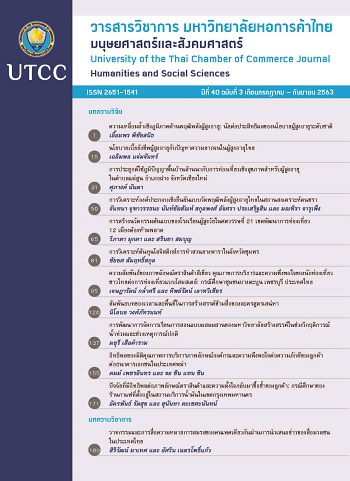การพัฒนาการจัดการเรียนการสอนแบบผสมผสานของมหาวิทยาลัยสร้างสรรค์ในช่วงวิกฤติการณ์น้ำท่วมและช่วงเหตุการณ์ปกติ
Main Article Content
บทคัดย่อ
งานวิจัยนี้มีวัตถุประสงค์ 2 ข้อ ได้แก่ 1) เพื่อศึกษาการทดลองใช้การสอนแบบผสมผสานและประสิทธิผลที่เกิดขึ้นระหว่างช่วงเกิดวิกฤติการณ์น้ำท่วม และ 2) เพื่อค้นหาและพัฒนาต้นแบบการเรียนรู้แบบผสมผสานและผลของการทดลองใช้ต้นแบบในเหตุการณ์ปกติ งานวิจัยนี้เป็นงานวิจัยระยะยาว ผู้ให้ข้อมูลแบ่งเป็น 4 กลุ่ม ได้แก่ 1) ผู้สอน 2) ผู้บริหารและเจ้าหน้าที่สายสนับสนุน 3) นักศึกษาในระดับปริญญาตรี และ 4) ผู้บริหาร เก็บข้อมูลด้วยแบบสอบถาม แบบสัมภาษณ์ และแบบสนทนากลุ่ม และวิเคราะห์ข้อมูลด้วยค่าความถี่ ร้อยละ และการวิเคราะห์เนื้อหา ผลการวิจัยพบว่า ในช่วงวิกฤติการณ์น้ำท่วม รูปแบบการเรียนการสอนแบบผสมผสานแบ่งเป็น 4 รูปแบบ ได้แก่ 1) การบรรยายในห้องเรียน 2) การทบทวนกลุ่มย่อย 3) การสอนผ่านระบบออนไลน์ และ 4) การศึกษาค้นคว้าหาความรู้ด้วยตนเอง รูปแบบดังกล่าวสามารถกระตุ้นความสนใจของผู้เรียน ลดความกดดันจากการเผชิญหน้า และเพิ่มประสิทธิภาพการเรียนรู้และทักษะชีวิตของผู้เรียน ส่วนในช่วงเหตุการณ์ปกติ รูปแบบการเรียนการสอนแทรกการเรียนออนไลน์ในบางสัปดาห์ การจัดกิจกรรมในห้องเรียนให้กลุ่มผู้นำเข้ามาร่วมออกแบบและจัดกิจกรรมการเรียนรู้ผ่านการลงมือปฏิบัติจริง ผลที่เกิดขึ้นกับผู้เรียน คือ ความสามารถในการประยุกต์ใช้ความรู้ผ่านการได้ลงมือปฏิบัติจากโจทย์จริง และการได้งานจากองค์กรภายนอก
Article Details
ลิขสิทธิ์ของบทความ
ผลงานที่ได้รับการตีพิมพ์ถือเป็นลิขสิทธิ์ของมหาวิทยาลัยหอการค้าไทย ห้ามมิให้นำเนื้อหา ทัศนะ หรือข้อคิดเห็นใด ๆ ของผลงานไปทำซ้ำ ดัดแปลง หรือเผยแพร่ ไม่ว่าทั้งหมดหรือบางส่วนโดยไม่ได้รับอนุญาตเป็นลายลักษณ์อักษรจากมหาวิทยาลัยหอการค้าไทยก่อน
เอกสารอ้างอิง
Ahmad, R., & Nisa, M. U. (2016). The significance of educational technology in teaching learning process. The International Journal of Indian Psychology, 4(1), 164-170.
Akbar, M. (2016). Digital technology shaping teaching practices in higher education. Frontiers in ICT, 3, 1-5.
Branoff, T. J., & Mapson, K. (2009). Large course redesign: Moving an introductory engineering graphics course from face-to-face to hybrid instruction. Proceedings of ASEE Southeast Section Conference. Retrieved from http:// http://se.asee.org/proceedings/ASEE2009/papers/PR2009024BRA.PDF
Brown, A., & Green, T. (2009). Issues and trends in instructional technology: Web 2.0, second life, and STEM share the spotlight. In M. Orey, V. J. McClendon, & R. M. Branch (Eds), Educational media and technology yearbook (pp. 7–23). New York: Springer.
Brown, A., & Green, T. (2011). Issues and trends in instructional technology: Lean times, shifts in online learning, and increased attention to mobile devices. In M. Orey, S. A. Jones, & R. M. Branch (Eds.), Educational media and technology yearbook (pp. 67–80). New York: Springer.
Drysdale, J. S., Graham, C. R., Spring, K. J., & Halverson, L. R. (2013). An analysis of research trends in dissertations and theses studying blended learning. The Internet and Higher Education, 17(1), 90-100.
Halverson, L. R., Graham, C. R., Spring, K. J., Drysdale, J. S., & Henrie, C. R. (2014). A thematic analysis of the most highly cited scholarship in the first decade of blended learning research. The Internet and Higher Education, 20, 20-34. doi:10.1016/j.iheduc.2013.09.004
Harrison, D. J., Saito, L., Markee, N., & Herzog, S. (2017). Assessing the effectiveness of a hybrid-flipped model of learning on fluid mechanics instruction: overall course performance, homework, and far-and near-transfer of learning. European Journal of Engineering Education, 42(6), 712-728.
Majumdar, S. (2015). Emerging trends in ICT for education & training. Retrieved October 12, 2019, from http://www.stthomascollegebhilai.in/wp -content/uploads/2016/10/emergingtrendsinictforeducationandtraining.pdf
Marsh, G.E., McFadden, A.C., & Price, B.J. (2003). Blended instruction: Adapting conventional instruction for large classes. Online Journal of Distance Learning Administration, 6(4), 1-11. Retrieved from http://www.westga.edu/distance/ojdla/winter64/marsh64.htm
Martyn, M. (2003). The hybrid online model: Good practice. Educause Quarterly, 26(1), 18-23.
Masrom, U. K., Alwi, N. A. N. M., & Asshidin, N. H. N. (2019). Understanding learners' satisfaction in blended learning among undergraduate students in Malaysia. Universal Journal of Educational Research, 7, 2233-2238. doi: 10.13189/ujer.2019.071023.
Murati, R., & Ceka, A. (2017). The use of technology in educational teaching. Journal of Education and Practice, 8(6), 197-199.
Powell, A., Rabbitt, B., & Kennedy, K. (2014). iNACOL blended learning teacher competency framework. Retrieved from https://files.eric.ed.gov/fulltext/ED561318.pdf
Saltan, F. (2017). Blended learning experience of students participating pedagogical formation program: Advantages and limitation of blended education. International Journal of Higher Education, 6(1), 63-73.
Sickel, J. L. (2019). The great media debate and TPACK: A multidisciplinary examination of the role of technology in teaching and learning. Journal of Research on Technology in Education, 51(2), 152-165.
Sotillo, S. M. (2000). Discourse functions and syntactic complexity in asynchronous communication. Language, Learning, and Technology, 4(1), 82-119.
Spring, K. J., & Graham, C. R. (2017). Thematic patterns in international blended learning literature, research, practices, and terminology. Online Learning, 21(4), 337-361. doi: 10.24059/olj.v21i4.998.
Staker, H. (2011). The rise of K-12 blended learning: Profiles of emerging models. Retrieved from https://files.eric.ed.gov/fulltext/ED535181.pdf
Staker, H., & Horn, M. B. (2012). Classifying K-12 blended learning. Retrieved from https://www.christenseninstitute.org/wp-content/uploads/2013/04/Classifying-K-12-blended-learning.pdf
Wongwanich, S. (2005). Alternative strategies for developing research and evaluation culture and capability of professional teacher. Journal of Research Methodology, 18(2), 193-211.


